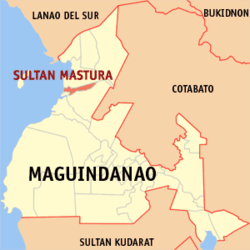Sultan Mastura, Maguindanao
| Sultan Mastura | |
|---|---|
| Municipality | |
| Municipality of Sultan Mastura | |
 Map of Maguindanao with Sultan Mastura highlighted | |
.svg.png) Sultan Mastura Location within the Philippines | |
| Coordinates: 7°17′00″N 124°18′00″E / 7.2833°N 124.3°ECoordinates: 7°17′00″N 124°18′00″E / 7.2833°N 124.3°E | |
| Country |
|
| Region | Autonomous Region in Muslim Mindanao (ARMM) |
| Province | Maguindanao |
| District | 1st District |
| Founded | April 28, 2003 |
| Barangays | 13 (see Barangays) |
| Government [1] | |
| • Type | Sangguniang Bayan |
| • Mayor | Rauf Mastura |
| • Electorate | 12,899 voters (2016) |
| Area [2] | |
| • Total | 242.07 km2 (93.46 sq mi) |
| Population (2015 census)[3] | |
| • Total | 22,261 |
| • Density | 92/km2 (240/sq mi) |
| Time zone | UTC+8 (PST) |
| ZIP code | 9605 |
| PSGC | 153824000 |
| IDD : area code | +63 (0)64 |
| Climate type | Tropical climate |
| Income class | 5th municipal income class |
| Revenue (₱) | 70,870,742.53 (2016) |
| Native languages |
Maguindanao language Iranun Tagalog |
Sultan Mastura, officially the Municipality of Sultan Mastura, is a 5th class municipality in the province of Maguindanao, Philippines. According to the 2015 census, it has a population of 22,261 people.[3]
It was created by virtue of the Muslim Mindanao Autonomy Act No. 89, carved from the municipality of Sultan Kudarat.[4] The law was submitted on September 13, 1999 and lapsed into law on November 13, 1999. It was ratified by the people of Sultan Mastura through plebiscite on March 15, 2003. Its corporate existence started on April 28, 2003.
It was part of the province of Shariff Kabunsuan from October 2006 until its nullification by the Supreme Court in July 2008.
Barangays
Sultan Mastura is politically subdivided into 13 barangays.
- Balut
- Boliok
- Bungabong
- Dagurongan
- Kirkir
- Macabico (Macabiso)
- Namuken
- Simuay/Seashore
- Solon
- Tambo
- Tapayan
- Tariken
- Tuka
Demographics
| Population census of Sultan Mastura | ||
|---|---|---|
| Year | Pop. | ±% p.a. |
| 2007 | 25,741 | — |
| 2010 | 21,712 | −6.01% |
| 2015 | 22,261 | +0.48% |
| Source: Philippine Statistics Authority[3][5][6][7] | ||
References
- ↑ "Municipality". Quezon City, Philippines: Department of the Interior and Local Government. Retrieved 31 May 2013.
- ↑ "Province: Maguindanao". PSGC Interactive. Quezon City, Philippines: Philippine Statistics Authority. Retrieved 12 November 2016.
- 1 2 3 Census of Population (2015). "ARMM – Autonomous Region in Muslim Mindanao". Total Population by Province, City, Municipality and Barangay. PSA. Retrieved 20 June 2016.
- ↑ "Muslim Mindanao Autonomy Act No. 89; An Act Creating the Municipality of Sultan Mastura in the Province of Maguindanao, Authorizing the Appropriation of Funds therefor, and for Other Purposes" (PDF). Regional Legislative Assembly, Autonomous Region in Muslim Mindanao. Retrieved 27 January 2016.
- ↑ Census of Population and Housing (2010). "ARMM – Autonomous Region in Muslim Mindanao". Total Population by Province, City, Municipality and Barangay. NSO. Retrieved 29 June 2016.
- ↑ Censuses of Population (1903–2007). "ARMM – Autonomous Region in Muslim Mindanao". Table 1. Population Enumerated in Various Censuses by Province/Highly Urbanized City: 1903 to 2007. NSO.
- ↑ "Province of Maguindanao". Municipality Population Data. Local Water Utilities Administration Research Division. Retrieved 17 December 2016.
External links
- MMA Act No. 89 : An Act Creating the Municipality of Sultan Mastura in the Province of Maguindanao
- Official Website of Sultan Mastura Municipality
- Philippine Standard Geographic Code
- Philippine Census Information
- Local Governance Performance Management System
- Inquirer.net, Sultan Kudarat town aims for nat’l recognition
This article is issued from
Wikipedia.
The text is licensed under Creative Commons - Attribution - Sharealike.
Additional terms may apply for the media files.